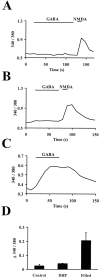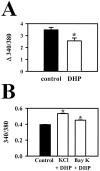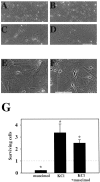Slow death of postnatal hippocampal neurons by GABA(A) receptor overactivation
- PMID: 10777778
- PMCID: PMC6773103
- DOI: 10.1523/JNEUROSCI.20-09-03147.2000
Slow death of postnatal hippocampal neurons by GABA(A) receptor overactivation
Abstract
Neurotransmitters can have both toxic and trophic functions in addition to their role in neural signaling. Surprisingly, chronic blockade of GABA(A) receptor activity for 5-8 d in vitro enhanced survival of hippocampal neurons, suggesting that GABA(A) receptor overactivation may be neurotoxic. Potentiating GABA(A) receptor activity by chronic treatment with the endogenous neurosteroid (3alpha,5alpha)-3-hydroxypregnan-20-one caused massive cell loss over 1 week in culture. Other potentiators of GABA(A) receptors, including benzodiazepines, mimicked the cell loss, suggesting that potentiating endogenous GABA activity is sufficient to produce neuronal death. Neurosteroid-treated neurons had lower resting intracellular calcium levels than control cells and produced smaller calcium rises in response to depolarizing challenges. Manipulating intracellular calcium levels with chronic elevated extracellular potassium or with the calcium channel agonist Bay K 8644 protected neurons. The results may have implications for the mechanisms of programmed cell death in the developing CNS as well as implications for the long-term consequences of chronic GABAmimetic drug use during development.
Figures









Similar articles
-
Effect of beta-estradiol on voltage-gated Ca(2+) channels in rat hippocampal neurons: a comparison with dehydroepiandrosterone.Eur J Pharmacol. 2001 Mar 30;416(3):203-12. doi: 10.1016/s0014-2999(01)00880-9. Eur J Pharmacol. 2001. PMID: 11290370
-
Prolongation and enhancement of gamma-aminobutyric acid receptor mediated excitation by chronic treatment with estradiol in developing rat hippocampal neurons.Eur J Neurosci. 2005 Jun;21(12):3251-61. doi: 10.1111/j.1460-9568.2005.04175.x. Eur J Neurosci. 2005. PMID: 16026463
-
Complex influence of the L-type calcium-channel agonist BayK8644(+/-) on N-methyl-D-aspartate responses and neuronal survival.Neuroscience. 1999 Mar;89(1):101-8. doi: 10.1016/s0306-4522(98)00312-1. Neuroscience. 1999. PMID: 10051220
-
Mu-opioid and GABA(B) receptors modulate different types of Ca2+ currents in rat nodose ganglion neurons.Neuroscience. 1998 Aug;85(3):939-56. doi: 10.1016/s0306-4522(97)00674-x. Neuroscience. 1998. PMID: 9639286
-
gamma-Aminobutyric acid(A) neurotransmission and cerebral ischemia.J Neurochem. 2001 Apr;77(2):353-71. doi: 10.1046/j.1471-4159.2001.00274.x. J Neurochem. 2001. PMID: 11299298 Review.
Cited by
-
Pathogenesis of peroxisomal deficiency disorders (Zellweger syndrome) may be mediated by misregulation of the GABAergic system via the diazepam binding inhibitor.BMC Pediatr. 2004 Mar 12;4:5. doi: 10.1186/1471-2431-4-5. BMC Pediatr. 2004. PMID: 15102341 Free PMC article.
-
Flux of signalling endosomes undergoing axonal retrograde transport is encoded by presynaptic activity and TrkB.Nat Commun. 2016 Sep 30;7:12976. doi: 10.1038/ncomms12976. Nat Commun. 2016. PMID: 27687129 Free PMC article.
-
Cyclodextrins sequester neuroactive steroids and differentiate mechanisms that rate limit steroid actions.Br J Pharmacol. 2007 Jan;150(2):164-75. doi: 10.1038/sj.bjp.0706973. Epub 2006 Dec 11. Br J Pharmacol. 2007. PMID: 17160009 Free PMC article.
-
Homeostatic effects of depolarization on Ca2+ influx, synaptic signaling, and survival.J Neurosci. 2003 Mar 1;23(5):1825-31. doi: 10.1523/JNEUROSCI.23-05-01825.2003. J Neurosci. 2003. PMID: 12629186 Free PMC article.
-
Effects of prenatal stress on the activity of an enzyme involved in neurosteroid synthesis during the "critical period" of sexual differentiation of the brain in male rats.Neurosci Behav Physiol. 2005 Nov;35(9):931-5. doi: 10.1007/s11055-005-0148-4. Neurosci Behav Physiol. 2005. PMID: 16270175
References
-
- Ankarcrona M. Glutamate induced cell death: apoptosis or necrosis? Prog Brain Res. 1998;116:265–272. - PubMed
-
- Castoldi AF, Barni S, Randine G, Costa LG, Manzo L. Ethanol selectively interferes with the trophic action of NMDA and carbachol on cultured cerebellar granule neurons undergoing apoptosis. Brain Res Dev Brain Res. 1998;111:279–289. - PubMed
-
- Chen Q, Olney JW, Lukasiewicz PD, Almli T, Romano C. Ca2+-independent excitotoxic neurodegeneration in isolated retina, an intact neural net: a role for Cl− and inhibitory transmitters. Mol Pharmacol. 1998;53:564–572. - PubMed
-
- Cherubini E, Rovira C, Gaiarsa JL, Corradetti R, Ben Ari Y. GABA mediated excitation in immature rat CA3 hippocampal neurons. Int J Dev Neurosci. 1990;8:481–490. - PubMed
Publication types
MeSH terms
Substances
Grants and funding
LinkOut - more resources
Full Text Sources
